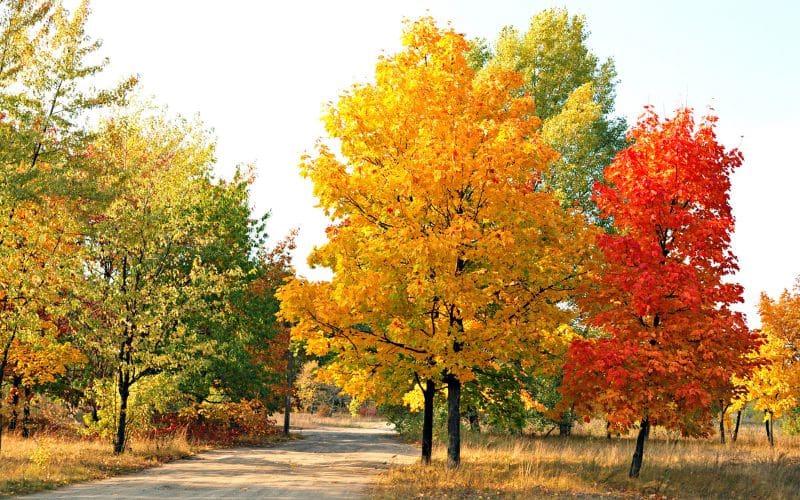
Why Maple Trees are the Heartbeat of Ontario
The maple tree! A symbol of Canadian identity and a staple in Ontario’s lush landscapes. But what makes these trees so special? Let’s embark on a journey to uncover the secrets of Ontario’s native maple trees.
What Makes the Maple Tree So Iconic in Ontario?
The maple tree is more than just a pretty face in Ontario’s forests. Its versatility, beauty, and economic contributions make it a cornerstone of the province. From the sugar maple’s vibrant autumn leaves to the silver maple’s adaptability, each species has its unique charm.
The Sweet Science of Acer Saccharum: How Does Sugar Maple Stand Out?
The sugar maple, or Acer saccharum, is the star of the maple family. Known for its sap, which is the key ingredient in maple syrup, this tree is a cultural and economic gem. But it’s not just about the syrup; the sugar maple’s leaves are a spectacle in the fall, turning into a kaleidoscope of colors that blanket the forest floor.

Is Silver Maple the Unsung Hero of Ontario’s Forests?
Meet the silver maple, Acer saccharinum. Often overshadowed by its sugar sibling, the silver maple is a marvel in its own right. Its leaves have a unique silver underside, and it’s one of the fastest-growing maples, making it a popular choice for urban landscaping.
Red Maple vs. Sugar Maple: What’s the Difference?
While the sugar maple gets most of the limelight, let’s not forget the red maple. With its brilliant red leaves and adaptability, the red maple is a staple in Ontario’s diverse ecosystems. Unlike the sugar maple, it thrives in a variety of soil conditions, making it a versatile member of the Acer family.
How is Maple Syrup Harvested in Ontario?
Maple syrup, the liquid gold of Ontario! Harvesting it is a springtime ritual that involves tapping the sugar maple’s sap. The sap is then boiled down to produce that sweet, sticky goodness we all love. It’s a labor of love that pays homage to the maple tree’s significance in Ontario’s heritage.
Why is the Maple Leaf a Symbol of Canadian Identity?
The maple leaf isn’t merely an emblem stitched onto our national flag; it’s a profound symbol that encapsulates the essence of Canadian values—unity, strength, and resilience. This iconic leaf serves as a mirror, reflecting the diverse cultures and communities that enrich our nation. In Ontario, the presence of various maple species, from the sugar maple to the silver maple, amplifies this symbolism. These trees stand tall, much like the province’s diverse population, each contributing its unique qualities to create a harmonious whole. In this way, the maple tree becomes more than just flora; it’s a living, breathing emblem of Ontario’s—and by extension, Canada’s—rich cultural mosaic.
Manitoba Maple: A Controversial Native or an Invader?
The Manitoba maple is a bit of a wildcard. Native to Manitoba, it has found its way into Ontario’s landscapes. While some consider it invasive, others see it as a hardy survivor. Regardless of your stance, there’s no denying that the Manitoba maple adds a unique flair to Ontario’s forests.
Striped Maple: The Underdog of Acer Species
The striped maple is the lesser-known member of the Acer family. With its distinctively striped bark and three-lobed leaves, it’s a rare but fascinating find in Ontario’s woodlands. Though not as popular as its cousins, the striped maple holds its own in the biodiversity arena.

Native Trees of Ontario: How Do Maples Compare?
Ontario’s forests are a living library of native trees, each with its own story to tell. Yet, among this diverse cast, the maple tree stands as a beloved protagonist. Whether it’s the sugar maple, known for its autumnal fireworks and syrupy gifts, or the elusive striped maple, each species plays a unique role in shaping Ontario’s environmental narrative. These trees are more than just passive elements in our landscape; they’re active contributors to Ontario’s ecological health and cultural fabric. In essence, maples are not merely trees; they’re the leafy ambassadors of Ontario’s rich environmental and cultural legacy.
Conclusion: The Future of Maple Species in Ontario
As we look to the future, the role of maple trees in Ontario’s ecosystems remains crucial. Climate change poses challenges, but the resilience and adaptability of these trees give us hope. Whether it’s the sugar maple’s sap or the silver maple’s rapid growth, each tree has a role to play in preserving Ontario’s natural beauty.
So the next time you find yourself in an Ontario forest, take a moment to appreciate the maple trees around you. They’re not just part of the landscape; they’re part of our collective story.
And there you have it! A journey through the heart of maple country in Ontario. From the Acer saccharum to the forest floor, each maple tree is a chapter in Ontario’s rich ecological and cultural narrative.








